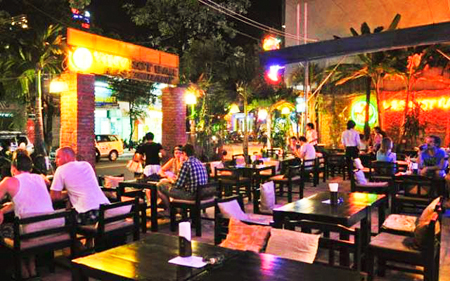
According to the World Health Organization (WHO), smoking not only affects the health of smokers but also of those around them...
According to the World Health Organization (WHO), smoking not only affects the health of smokers but also of those around them. Active and passive smokers are equally exposed to serious adverse diseases caused by inhaling smoke.
 |
| A restaurant in Nha Trang City. |
One of methods to minimize harmful effects on passive smokers’ health is building non-smoking environment in public places. Building a model of building smoke-free restaurants is part of efforts to protect the human right to live in a healthy smoke-free environment, helping to minimize risks of diseases and deaths caused by passive smoking. Under the Law on Tobacco Control, restaurants are listed as indoor public areas where smoking is completely banned, says Dr. Nguyen The Tai, Vice-Director of Khanh Hoa Tuberculosis Lung Diseases Hospital.
A survey conducted by Hanoi University of Public Health and HealthBridge Foundation of Canada in Vietnam from May 2015 to September 2016 on 970 people at 195 restaurants in Hanoi showed promising results. In restaurants where tobacco control regulations are implemented, the number of customers and turnover remain unchanged or even up 8.1% and 5.7% respectively. 25.1% of restaurants adopted smoke-free regulations in 2015 and the figure has nearly doubled to 44.1% this year. 82.6% of restaurant owners know the Law on Tobacco Control in restaurants and 85.6% of restaurant owners are in favor of building smoke-free environment.
However, the survey also indicates challenges of the implementation of non-smoking regulations. Restaurants have not fully met criteria for smoke-free places such as their failure to remind customers of smoking bans or punish staff for smoking in restaurants. Some restaurant owners argue that smoke-free policy compliance will result in a loss of revenue as a result of smokers visiting these establishments less frequently. This common challenge can be seen not only in Hanoi, but also in Khanh Hoa.
For effective implementation of the model, more propaganda is required to improve restaurant owners’ awareness of the Tobacco Control Law and smoke-free restaurant regulations. Pledges to build smoke-free restaurants are needed to be signed by restaurant owners together with more supervision and provision of data about restaurants’ implementation of smoke-free legislation so that restaurant owners can fully recognize benefits of smoke-free regulations in restaurants, according to Director of HealthBridge organization Pham Thi Hoang Anh.
Building a smoke –free environment brings great benefit to life. Therefore, joint effort by local authorities, organizations and individuals is required to raise public awareness of implementing the Tobacco Control Law and building smoke-free environment, especially in restaurants.
HealthBridge Foundation of Canada in Vietnam has defined 8 smoke-free restaurant criteria, including non-smoking signs; no ashtrays and cigarette-lighter present on tables; no smoking and cigarette-end; staff’s reminding customers to stop smoking; punishment applied on staff smoking in restaurants; no cigarette sales; no cigarette ad, promotion or marketing in restaurants; and not receiving direct or indirect aid from tobacco companies or relevant organizations.
T.L
Translated by N.T










